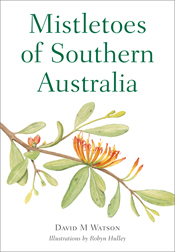
 Mistletoes are an enigmatic group of plants. Lacking roots and depending on other plants for their livelihood, they have inspired a range of beliefs throughout the world. Some people regard them as mystical plants endowed with magical properties, others as destructive weeds that devalue native habitats, and still others as beautiful native plants that support wildlife.
Mistletoes are an enigmatic group of plants. Lacking roots and depending on other plants for their livelihood, they have inspired a range of beliefs throughout the world. Some people regard them as mystical plants endowed with magical properties, others as destructive weeds that devalue native habitats, and still others as beautiful native plants that support wildlife.| Preface Acknowledgements Biology Identification Species accounts: Loranthaceae Visaceae Ecology Cultural significance Management Species list References Index |
| Colour Paintings, Colour photographs 200 pages, 245 x 170 mm Publisher: CSIRO PUBLISHING |
Paperback - 2011 ISBN: 9780643095939 - AU $ 49.95 |
 |
To purchase, visit CSIRO Publishing by clicking here |